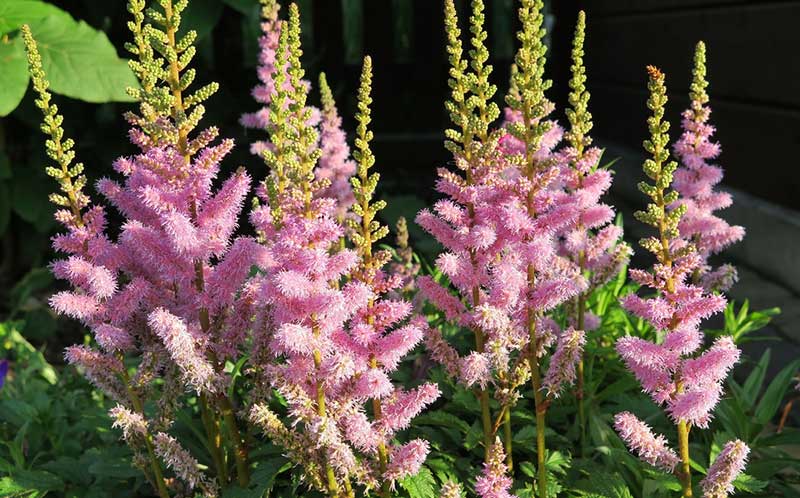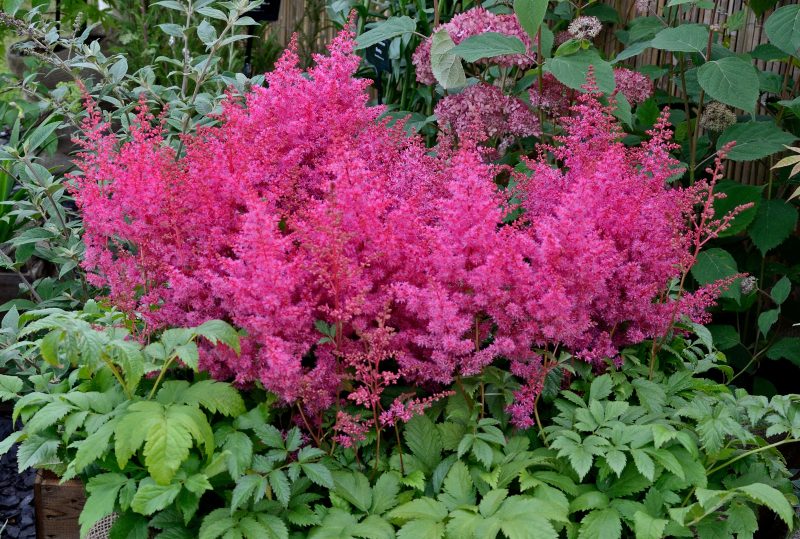
The astilbe comes in a number of varieties with different bloom times. Some bloom in the early spring, others during the summer, and some wait until almost the fall.
Depending on the variety you choose, they are hardy from zones 3 through 9. The bright colors of the astilbe make them a favorite for vibrant pops of color.
They will bloom for up to six weeks. Depending on the variety you choose, they may grow anywhere from 8″ tall to 4′ with the flower clusters ranging anywhere from 6″ to 2′ long.
They come in a wide variety of colors, including white, deep red, dark purple, and light pink. Some varieties also have bright foliage colors such as burgundy, chocolate, and bronze.
Light and Temperature Requirements
These plants like both shade and partial shade as well as filtered sun. Full sun is generally too much for them to thrive unless you are in a northern zone with a cooler climate. Many gardeners like to plant them in the shade because they bring such bright colors to the darker areas of the landscaping. In warmer zones, full sun will scorch the leaves of the astilbe. The plant is hardy in cold temperatures, even when the climate is cold and harsh. After the fall’s first frost, put a 2″-layer of mulch around the plant to keep its soil warmer.
Watering
Water is a major need of the astilbe. It is not drought tolerant and likes to be watered often. In warmer months, it will need more water to offset the hot temperatures. If the plant is located in an area of full sun, it will need still more. If it is kept dry for too long, the leaves will begin to dry up and turn brown, and the plant will die shortly after that. To keep it healthy, keep the moisture level in the soil even and damp without making it soggy.

Soil & Fertilizing
Every variety of the astilbe prefers to be in soil that is moist, cool, and has plenty of organic material. It should not be planted in soils that have poor drainage such as heavy clay. If you have poor soil, you can add compost or other organic materials to the soil as well as rocks and/or sand to help it to drain better.
These plants must have phosphorus in order to bloom, so fertilizing them can help to keep them healthy and blooming. Choose a 10-10-10 or a 5-10-5 fertilizer and work it into the soil before you plant your astilbe. You can also use granules added to the soil every spring after it has been planted and become established.
Deadheading and Pruning
Even after the flowers of the astilbe dries up at the end of the season, it will stay looking bold and beautiful for several months. Whenever they begin to have a ragged look, they can be deadheaded. However, many people leave the flowers in place during the winter for the extra color and texture they give to the landscaping. The dead blooms can then be cut away the next spring to make room for new flowers. There is no other pruning needed to keep the plant healthy, though it’s ok to cut away dead foliage to keep the plant looking its best.
Propagation
The astilbe spreads with rhizomes underground. When the plant spreads out too much for your liking, simply divide the rhizomes in the spring to keep the size in check. This generally is done every four or five years. Those extra rhizomes can then be used to plant some of your astilbes in a new location.





